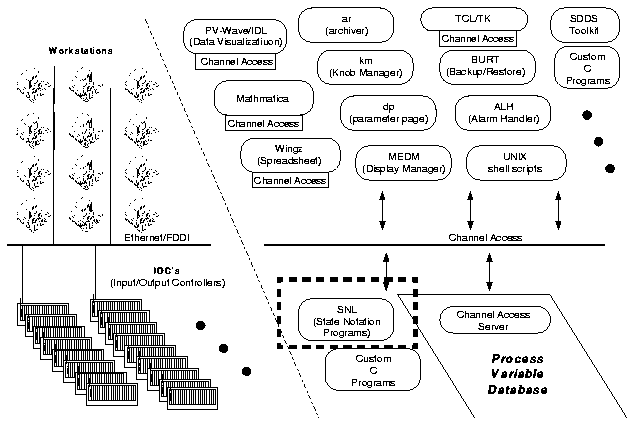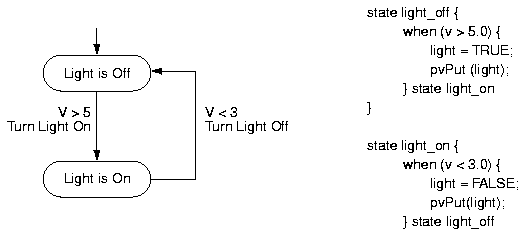State Notation Language Overview
Ned Arnold
May 1996
Table of Contents
- Allows programming of sequential "state-oriented" operations to run in the IOC
- The program interacts with the run-time database(s) via channel access
-
Latest SNL manual version 1.9 at LANL

- State machines
- Startup sequences
- Enforce prudent operational procedures
- Watch for likely fault modes that are hard to detect via alarms
- Implement complex closed loop control schemes
- Coordinate control of multiple devices
- Can implement complicated algorithms
- Can stop, reload, restart a sequence program without rebooting
- "Converse" with the operator through a string_in record
- C code can be embedded as part of the sequence
- All Channel Access "hassles" are taken care of for you
- File access can be implemented as part of the sequence
- SNL : State Notation Language
- SNC : State Notation Compiler
- sequencer : The tool within the IOC that executes the compiled SNL code
- Program : A complete SNL application consisting of declarations and one or more state sets
- State Set : A set of states that make a complete state machine
- State : A particular "mode" of the program in which it remains until a transition statement is evaluated to be TRUE
- The SNL code structure follows a "state transition diagram" format

- Once in a given state, "when" conditions are specified under which to leave that state
- Action statements are executed during the transition from one state to another
- Access to Process Variables via channel access is accomplished by simply "assigning" a PV to a sequence variable
-------------------------------------------------------------------------------------------
program level_check ss volt_check { ss generate_voltage {
state light_off { state init {
float v; when (v > 5.0) { when () {
assign v to "ts1:ai1"; /* turn light on */ vout = 0.0;
monitor v; light = TRUE; pvPut(vout);
short light; pvPut(light); delta = 0.2;
assign light to ) state light_on; } state ramp
"Indicator_light"; } }
float vout; state light_on { state ramp {
float delta; when (v < 5.0) { when (delay (0.1)) {
assign vout to "ts1:ai1"; /* turn light off */ if ((delta > 0.0 &&
light = FALSE; vout >= 11.0) ||
pvPut (light); (delta < 0.0 &&
} state light_off; vout <= -11.0))
} /*change direction*/
} delta = -delta;
vout += delta;
pvPut(vout);
} state ramp;
}
}
-------------------------------------------------------------------------------------------
- A state can have multiple "when" statements. The first one to be evaluated to be TRUE will be executed. This allows "conditional branching" within the sequence program.
- When entering a state, all "when" statements are evaluated
- If no "when" is true, sequence program task "pends" until an event occurs
- It is possible to create a "loop" and consume all available CPU
state checks {
when (interlockChasPwrBi == 0) {
sprintf(seqMsg1, "Electron Gun Not Ready...");
pvPut(seqMsg1);
sprintf(seqMesg2, "Gun Interlock Chassis off");
pvPut(seqMsg2);
} state initialChecks
when (gunLocal) {
sprintf(seqMsg1, "Electron Gun Not Ready...");
pvPut(seqMsg1);
sprintf(seqMesg2, "Egun in local control");
pvPut(seqMsg2);
} state initialChecks
when (gunInterlocksRdyCC == 0) {
sprintf(seqMsg1, "Electron Gun Not Ready...");
pvPut(seqMsg1);
sprintf(seqMesg2, "Interlocks not OK");
pvPut(seqMsg2);
} state initialChecks
when (interlockChasPwrBI && (gunLocal == 0) && gunInterlocksRdyCC) {
gunAutoStart = 0;
pvPut(gunAutoStart);
gunAutoStop = 0;
pvPut(gunAutoStop);
sprintf(seqMsg1, "Push Auto-Start to begin autostart...");
pvPut(seqMsg1);
sprintf(seqMesg2, "Push Auto-Stop to begin autostop...");
pvPut(seqMsg2);
%% taskDelay(60);
} state waitForRequest
}
state initialChecks {
when (delay(2.0)) {
sprintf(seqMsg1, "Initial Checks");
pvPut(SeqMsg1);
sprintf(seqMesg2, "");
pvPut(seqMsg2);
%% taskDelay(60);
} state checks
}
- Assignment of "macros" at program startup (multiple copies of same sequence)
- Arrays (each element can be assigned to a PV)
- Event Flags (used to sync state sets)
- Built-In functions (pg 18 of Manual)
- seqShow
- seqChanShow
- printf("Here I am in state xyz \n");
- td xxxxxx
- ld < my_sequence_program.o
- seq &my_sequence_program.o
- Compensate for Attenuator Phase Shift when adjusted
- Automatically check timing of BPM's
- E-gun startup
- Modulator startup
- Automatic Test Sequences (240 Inputs to the MPS)
- BPM Trajectory Plot


